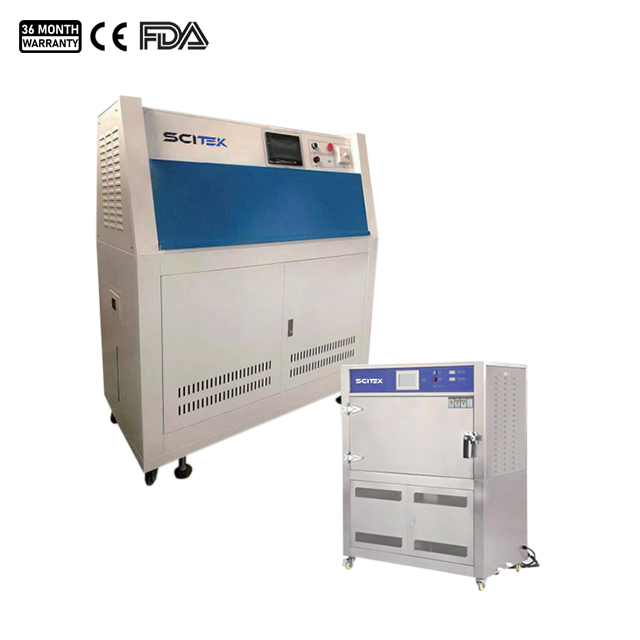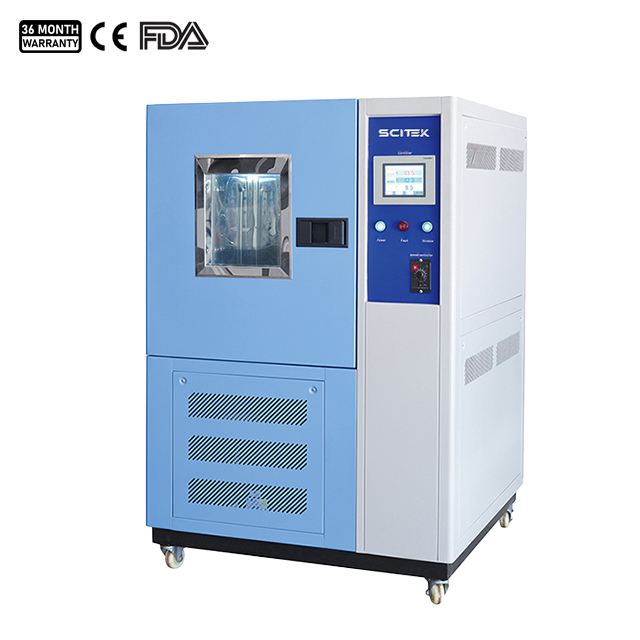Aging test is an important experiment to improve the stability and reliability of the product, and it is an important production process for each manufacturer to improve product quality and competitiveness.
What is aging test
Aging test mainly refers to the thermal and oxygen aging test for rubber, electronic parts, plastic products, electrical insulation materials and other materials;
Aging test is divided into temperature aging, sunlight aging, loading aging and so on. There are many commonly used aging test methods, including climate aging test, ultraviolet aging test, ozone aging test, high and low temperature alternating aging test, media aging test, humidity and heat aging test, hot air aging test, salt spray aging test and so on.
Eight aging test methods:
UV Aging Test
Principle
Ultraviolet light from the sun causes degradation of polymer materials, so they are usually tested in a laboratory using a UV accelerated aging tester.
The UV Aging Test makes use of this characteristic of UV to irradiate polymer materials in order to obtain the aging behavior and pattern of polymer materials.
The light sources used in UV aging tests are usually fluorescent lamps, xenon lamps, tritium lamps and so on. Among them, xenon lamps can well simulate the solar spectrum; fluorescent lamps can simulate the ultraviolet spectrum of sunlight; tritium lamps can provide strong energy, generally used for accelerated aging tests.
Applications
UV Aging Test involves a wide range of product areas, such as rubber, plastic and its products, coatings, paints, dyes, fabrics, printing and packaging, adhesives, metals, electronics, electroplating, cosmetics and so on.
UV Aging Test Equipment
In just a few weeks or months, reproducible and reliable aging test data can be obtained from UV aging test chambers; their short-wavelength UV illumination and condensation circulation systems realistically simulate the damaging effects of sunlight, dew and rain, etc. on materials.

UV Aging Test Chamber
Number of Lamps : 8
Lamp Life More than : 1600 hours
Temperature Range : RT + 10℃ ~70℃
Humidity Range : 75% RH
External Size (WxDxH)(mm) : 1300x800x1550
Ozone Aging Test
Principle
During operation, the ozone generator in the test chamber produces ozone through a specific chemical reaction, creating a highly concentrated ozone environment. The ozone rapidly reacts with the molecules on the surface of the material, thus simulating the aging process of the material due to oxidation in the actual environment.
In addition, the temperature, humidity and other factors inside the ozone aging chamber can be adjusted to simulate different environmental conditions, such as the tropics, deserts, oceans and so on.
Applications
Automotive industry: Rubber parts of automobiles such as door seals, wipers, axle covers, fuel hoses, tires, etc. need to undergo ozone aging tests to check their service life.
Aerospace industry: The fatigue strength of rubber parts and rubber elastomers for aircraft is a specific safety check. The same applies to cables for maglev trains.
Cable industry: For cables and their insulation, ozone aging tests are required to ensure that they can work for a long time.
Semiconductor industry: The technology of using ozone to clean wafers in the semiconductor industry has been established, and ozone oxidation of organic and metallic contaminants in the water is also widely utilized.
Ozone Aging Test Equipment

Ozone Aging Test Chamber
Temperature Range : 0℃~70℃
Humidity Range : 30~65%R.H
Ozone Concentration : 20~1000pphm
Temperature Fluctuation : ±0.5℃
Gas Flow Rate : 12~16mm/s
Climate Aging Test
Climate aging test is to expose the test samples of polymer materials to atmospheric conditions, to obtain the aging pattern of the material samples exposed to the atmospheric environment. This is a research method to analyze the performance of polymer materials and predict their service life.
There are two types of climate aging tests one is the natural exposure test, which exposes the polymer material test samples to the real atmospheric environment to obtain the aging behavior of the material in the real environment. This type of aging test method is too long a cycle and time-consuming.
Another category is the use of a climate aging test chamber indoors to simulate the real atmospheric environment, in order to obtain the aging behavior of the material in a short period. Commonly used artificial climate aging chambers are mainly xenon lamp climate aging chambers, fluorescent lamp climate aging test chambers, carbon arc lamp climate aging test chambers and so on.

Climate Aging Test Chamber
Circulation Mode : Forced convection
Temperature Range (℃) : With light: 10~55; Without light: 5~55
Humidity Range : 30~95%RH
Humidity Method : Internal
Hot Air Aging Test
Principle
Heat can accelerate the movement of polymer chains, leading to the breakage of polymer chains, the generation of reactive free radicals, and free radical chain reactions, causing degradation or exchange of polymers.
Hot air aging test is one of the main test methods for evaluating polymer materials and researching the aging resistance of polymer materials, and it is usually carried out in Forced Air Drying Oven. The temperature in the drying oven can be set according to the test requirements, and the polymer materials are periodically sampled and dried for the test. The polymer material is then modified in a targeted manner to improve its performance.
Applications
Hot air aging testing is a common accelerated aging test method used to evaluate changes in the performance of materials, components or products when exposed to high temperatures. It is commonly used in the life assessment of plastics, rubber, construction materials and electronic components.
Hot Air Aging Test Equipment
Salt spray corrosion aging test
Salt Spray Corrosion Test Chambers come in the form of a mist or ultra-fine fog, creating an environment that accelerates corrosion. Cyclic corrosion testing of samples is required to gain a more complete understanding of a product's or component's ability to resist corrosion in real-world environments. Cyclic corrosion testing is critical for companies in the offshore industry. Metal components underwater are subject to galvanic and stray current corrosion. Without proper monitoring and avoidance, these forms of corrosion can severely damage your vessels, propellers and engines.
Application
Phosphate surfaces with subsequent application of paint, primer, varnish or rust inhibitor
Zinc and zinc alloy plating
Electroplating of chrome, nickel, copper and tin
Non-electrolytically applied coatings, e.g. zinc flake coatings
Organic coatings
Paint coatings
Hot Air Aging Test Equipment
Temperature rubber aging test
For rubber, high temperature accelerates the thermal movement of molecular chains, causing cross-linking of rubber; low temperature freezes the molecular chains of rubber, making rubber brittle, less elastic and aging.
High and low temperature alternating aging test is a kind of aging test method to evaluate the temperature resistance of polymer materials. It is usually carried out in a temperature-alternating aging test chamber, and the performance of the product is determined by constant temperature cycling.
Damp Heat Aging Test
Under high humidity, water can penetrate the polymer material, causing it to swell. Some of the hydrophilic groups are hydrolyzed, resulting in degradation of the polymer material.
Under high heat, heat can promote water penetration and accelerate the degradation of the polymer material.
A damp heat aging test is usually carried out in a damp heat aging test chamber, the temperature and humidity can be set according to the test requirements.
Medium temperature aging test
Medium aging test is a common test method for evaluating the aging resistance of polymer materials and predicting their life expectancy in a certain medium. The medium used in the aging test can be formulated according to the specific environment of polymer materials, which can be salt water, fuel oil, acid and alkali solutions, rainwater, artificial seawater and other organic solvents.
The role of aging test
Evaluate product reliability: Aging test can simulate the life of the product in actual use, and evaluate the reliability of the product during its service life by analysing the test data of the product at different points in time.
Determine product quality: It helps manufacturers to determine the quality level of their products.
Reduce maintenance cost: Aging tests can help manufacturers reduce the maintenance cost of their products.

 English
English













